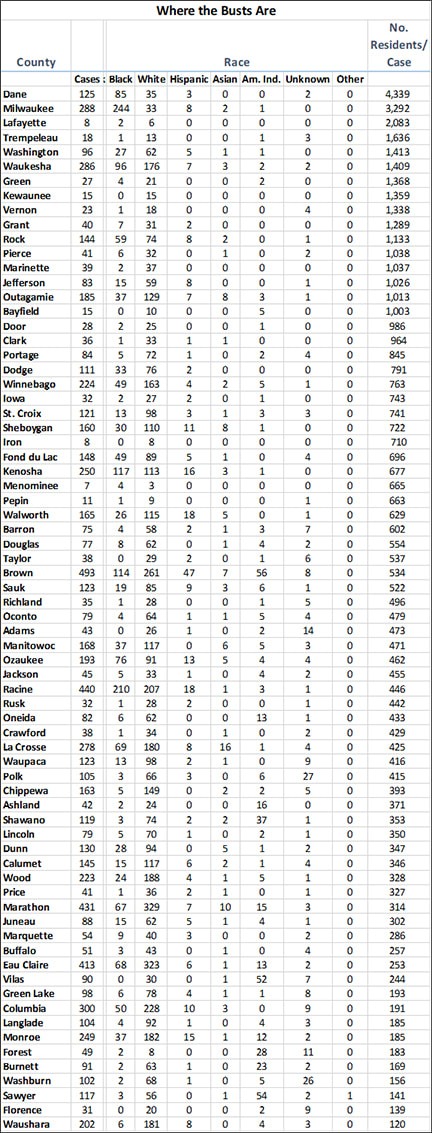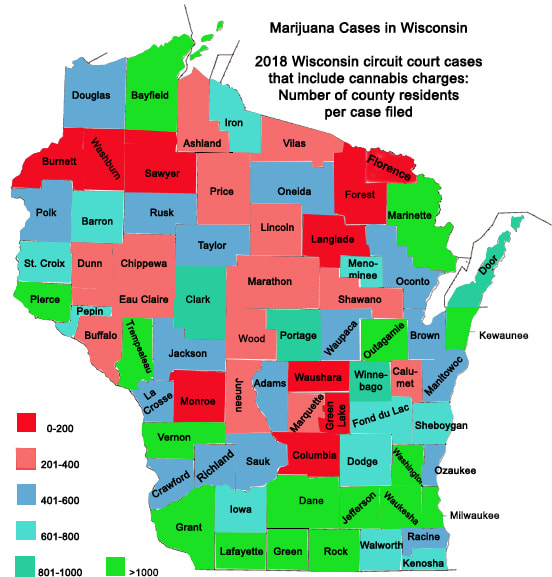Blacks More at Risk for Pot Prosecution
7% of state population but 21% of charges. Cannabis “the drug of the privileged”?
![Marijuana plant. Photo by Jennifer Martin (Own work) [CC BY-SA 4.0 (http://creativecommons.org/licenses/by-sa/4.0)], via Wikimedia Commons.](https://urbanmilwaukee.com/wp-content/uploads/2016/09/Marijuana_Plant_03.jpg)
Marijuana plant. Photo by Jennifer Martin (Own work) (CC BY-SA 4.0), via Wikimedia Commons.
The analysis included cannabis cases filed in each of the state’s 72 counties.
The figures demonstrate “that marijuana prosecutions impact more heavily on the African American population,” even though African Americans and whites use marijuana at about the same rates, said Craig Johnson, an attorney and board president of Wisconsin Justice Initiative.
The disparity “clearly points to another reason for legalizing it,” he said.
There were 8,697 Circuit Court cases that included misdemeanor or felony cannabis charges, the analysis shows, and African Americans were defendants in 1,846 of those cases.
Whites, who account for 87 percent of the state’s population, made up just 66 percent of defendants in marijuana cases, figures show. Whites were defendants in 5,776 cases.
American Indians / Alaska Natives also were over-represented among those facing cannabis charges. Members of that ethnic group account for about 1 percent of the state’s population, but 5 percent of cannabis defendants.
Hispanics and Asians were under-represented in marijuana cases. Hispanics make up 7 percent of the state’s population and were defendants in 3 percent of cannabis cases, and Asians accounted for 3 percent of the population and 1 percent of cannabis defendants.
The analysis also shows that the filing rate of criminal cases varies widely across the state. In Waushara County, for example, one cannabis case was filed for every 120 county residents, the highest rate in the state; in Dane County, one case was filed for every 4,339 residents, the lowest filing rate statewide. It was followed by Milwaukee County, where one cannabis case was filed for every 3,292 residents.
The black/white racial disparities in those latter two counties, however, were bigger than in any of the other 70 counties in the state.
In Dane County, African Americans account for just 5 percent of the population but were 68 percent (85 of 125) of cannabis defendants, for a disparity of 63 percentage points, the largest in the state.
In Milwaukee County, 27 percent of residents are African-American, but blacks accounted for 85 percent – (244 out of 288) – of cannabis case defendants, a gap of 58 percentage points, the state’s second highest.
Those figures, Johnson said, shows that cannabis “is kind of the drug of the privileged.”
There are some areas, he said, “where marijuana has sort of de facto legalization.” Those areas are generally whiter, wealthier and more liberal, he said.
“My gut feeling is your over-policed communities end up with more charges,” he said. “So we have unequal protection under the law.”
The analysis also showed that 75 percent of the defendants in cannabis cases statewide were men. Milwaukee had the largest share of male defendants at 95 percent, followed by Dane and Jefferson counties. Some 90 percent of cannabis defendants in each of those counties were men.
The cases included in the analysis were those with some sort of marijuana charge, whether felony or misdemeanor. WJI counted cases filed with misdemeanor marijuana charges as misdemeanors and those with felony marijuana charges as felonies.
Gretchen Schuldt writes a blog for Wisconsin Justice Initiative, whose mission is “To improve the quality of justice in Wisconsin by educating the public about legal issues and encouraging civic engagement in and debate about the judicial system and its operation.
If you think stories like this are important, become a member of Urban Milwaukee and help support real, independent journalism. Plus you get some cool added benefits.
Court Watch
-
No Unemployment Benefits For Worker Making Homophobic Remarks
 May 17th, 2022 by Gretchen Schuldt
May 17th, 2022 by Gretchen Schuldt
-
Appeals Court Upholds Injunction Against Abortion Protester
 Mar 13th, 2022 by Gretchen Schuldt
Mar 13th, 2022 by Gretchen Schuldt
-
80% of State’s Judicial Races Uncontested
 Feb 20th, 2022 by Gretchen Schuldt
Feb 20th, 2022 by Gretchen Schuldt






















